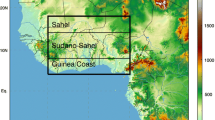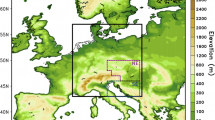Abstract
This study illustrates the sensitivity of regional climate change projections to the model physics. A single-model (MM5) multi-physics ensemble of regional climate simulations over the Iberian Peninsula for present (1970–1999) and future (2070–2099 under the A2 scenario) periods is assessed. The ensemble comprises eight members resulting from the combination of two options of parameterization schemes for the planetary boundary layer, cumulus and microphysics. All the considered combinations were previously evaluated by comparing hindcasted simulations to observations, none of them providing clearly outlying climates. Thus, the differences among the various ensemble members (spread) in the future projections could be considered as a matter of uncertainty in the change signals (as similarly assumed in multi-model studies). The results highlight the great dependence of the spread on the synoptic conditions driving the regional model. In particular, the spread generally amplifies under the future scenario leading to a large spread accompanying the mean change signals, as large as the magnitude of the mean projected changes and analogous to the spread obtained in multi-model ensembles. Moreover, the sign of the projected change varies depending on the choice of the model physics in many cases. This, together with the fact that the key mechanisms identified for the simulation of the climatology of a given period (either present or future) and those introducing the largest spread in the projected changes differ significantly, make further claims for efforts to better understand and model the parameterized subgrid processes.













Similar content being viewed by others
References
Argüeso D, Hidalgo-Muñoz JM, Gámiz-Fortis SR, Esteban-Parra MJ, Dudhia J, Castro-Díez Y (2011) Evaluation of WRF parameterizations for climate studies over Southern Spain using a multi-step regionalization. J Clim 24(21):5633–5651
Chen F, Dudhia J (2001) Coupling an advanced land surfacehydrology model with the Penn StateNCAR MM5 modeling system. Part I: model implementation and sensitivity. Mon Weather Rev 129(4):569–585
Christensen JH, Machenhauer B, Jones RG, Schär C, Ruti PM, Castro M, Visconti G (1997) Validation of present-day climate simulations over Europe: LAM simulations with observed boundary conditions. Clim Dyn 13:489–506
Christensen OB (1999) Relaxation of soil variables in a regional climate model. Tellus A 51(5):674–685
Deque M, Rowell DP, Lüthi D, Giorgi F, Christensen JH, Rockel B, Jacob D, Kjellstrm E, Castro MD, van den Hurk B (2007) An intercomparison of regional climate simulations for Europe: assessing uncertainties in model projections. Clim Change 81:53–70
Dudhia J (1989) Numerical study of convection observed during the winter monsoon experiment using a mesoscale two-dimensional model. J Atmos Sci 46(20):3077–3107
Evans JP (2008) Changes in water vapor transport and the production of precipitation in the eastern fertile crescent as a result of global warming. J Hydrometeorol 9(6):1390–1401
Evans JP (2010) Global warming impact on the dominant precipitation processes in the Middle East. Theoret Appl Climatol 99(3–4):389–402
Evans JP, Smith RB, Oglesby RJ (2004) Middle East climate simulation and dominant precipitation processes. Int J Climatol 24(13):1671–1694
Evans JP, Ekström M, Ji F (2012) Evaluating the performance of a WRF physics ensemble over South-East Australia. Clim Dyn. doi:10.1007/s00382-011-1244-5
Fernandez J, Montavez JP, Saenz J, Gonzalez-Rouco JF, Zorita E (2007) Sensitivity of the MM5 mesoscale model to physical parameterizations for regional climate studies: annual cycle. J Geophys Res 112:D04,101
Font-Tullot I (2000) Climatología de España y Portugal. Ed Universidad de Salamanca
Galos B, Lorenz P, Jacob D (2007) Will dry events occur more often in Hungary in the future? Environ Res Lett 2(3):034,006
Gianotti RL, Zhang D, Eltahir EAB (2012) Assessment of the regional climate model version 3 over the maritime continent using different cumulus parameterization and land surface schemes. J Clim 25(2):638–656
Giorgi F (2006) Climate change hot-spots. Geophys Res Lett 33:L08,707
Giorgi F, Bi X (2000) A study of internal variability of a regional climate model. J Geophys Res 105(D24):29503–29529
Gomez-Navarro JJ, Montavez JP, Jimenez-Guerrero P, Jerez S, Garcia-Valero JA, Gonzalez-Rouco JF (2010) Warming patterns in regional climate change projections over the Iberian Peninsula. Meteorol Z 19(3):275–285
Gomez-Navarro JJ, Montavez JP, Jerez S, Jimenez-Guerrero P, Lorente-Plazas R, Gonzalez-Rouco JF, Zorita E (2011) A regional simulation over the Iberian Peninsula for the last millenium. Clim Past 7(2):451–472
Gomez-Navarro JJ, Montavez JP, Jimenez-Guerrero P, Jerez S, Lorente-Plazas R, Gonzalez-Rouco JF, Zorita E (2012) Internal and external variability in regional simulations of the Iberian Peninsula climate over the last millennium. Clim Past 8:25–36
Grell GA (1993) Prognostic evaluation of assumptions used by cumulus parameterizations. Mon Weather Rev 121(3):764–787
Grell GA, Dudhia J, Stauffer DR (1994) A description of the fifth-generation Penn State/NCAR Mesoscale Model (MM5). NCAR Tech Note 398+STR, Natl Cent for Atmos Res, Boulder, CO
Han Z, Hiromasa U, An J (2008) Evaluation and intercomparison of meteorological predictions by five MM5-PBL parameterizations in combination with three land-surface models. Atmos Environ 42(2):233–249
Haugen JE, Iversen T (2008) Response in extremes of daily precipitation and wind from a downscaled multi-model ensemble of anthropogenic global climate change scenarios. Tellus A 60(3):411–426
Herrera S, Fita L, Fernandez J, Gutierrez JM (2010) Evaluation of the mean and extreme precipitation regimes from the ENSEMBLES regional climate multimodel simulations over Spain. J Geophys Res 115:D21
Hong SY, Pan HL (1996) Nonlocal Boundary Layer vertical diffusion in a medium-range forecast model. Mon Weat Rev 124:2322–2339
IPCC (2007) Summary for policymakers. In: Solomon S, Qin D, Manning M, Chen Z, Marquis M, Averyt KB, Tignor M, Miller HL (eds) Climate change 2007: the physical science basis. Contribution of working group I to the fourth assessment report of the intergovernmental panel on climate change, Cambridge University Press, Cambridge, UK
Jacob D, Barring L, Christensen OB, Christensen JH, de Castro M, Deque M, Giorgi F, Hagemann S, Lenderink G, Rockel B, Sanchez E, Schaer C, Seneviratne SI, Somot S, van Ulden A, van denHurk B (2007) An inter-comparison of regional climate models for Europe: model performance in present-day climate. Clim Change 81:31–52
Janjic ZI (1994) The step-mountain eta coordinate model: further developments of the convection, viscous sublayer, and turbulence closure schemes. Mon Weather Rev 122(5):927–945
Jerez S, Montavez JP, Gimenez D (2009) Optimizing the execution of a parallel meteorology simulation code. IEEE international symposium on parallel and distributed processing (Rome, 2009) pp 1–6
Jerez S, Montavez JP, Gomez-Navarro JJ, Jimenez-Guerrero P, Jimenez J, Gonzalez-Rouco JF (2010) Temperature sensitivity to the land-surface model in MM5 climate simulations over the Iberian Peninsula. Meteorol Z 19(4):363–374
Jerez S, Montavez JP, Gomez-Navarro JJ, Jimenez PA, Jimenez-Guerrero P, Lorente-Plazas R, Gonzalez-Rouco JF (2012a) The role of the land-surface model for climate change projections over the Iberian Peninsula. J Geophys Res 117:D01,109
Jerez S, Montavez JP, Jimenez-Guerrero P, Gomez-Navarro JJ, Lorente-Plazas R, Zorita E (2012b) A multi-physics ensemble of present-day climate regional simulations over the Iberian Peninsula. Clim Dyn. doi:10.1007/s00382-012-1539-1
Joshi M, Hawkins E, Sutton R, Lowe J, Frame D (2011) Projections of when temperature change will exceed 2 C above pre-industrial levels. Nature Clim Change 1(8):407–412
Jung G, Kunstmann H (2007) High-resolution regional climate modeling for the Volta region of West Africa. J Geophys Res (Atmospheres) 112(11):D23,108
Kain JS, Fritsch JM (1990) A one-dimensional entraining/detraining plume model and its application in convective parameterization. J Atmos Sci 47(23):2784–2802
Kanamitsu M, Ebisuzaki W, Woollen J, Yang SK, Hnilo JJ, Fiorino M, Potter GL (2002) NCEP-DOE AMIP-II reanalysis (R-2). Bull Am Meteorol Soc 83:1631–1643
Knutson TR, Tuleya RE (2004) Impact of CO2-induced warming on simulated hurricane intensity and precipitation: sensitivity to the choice of climate model and convective parameterization. J Clim 17(18):3477–3495
Koo GS, Boo KO, Kwon WT (2009) Projection of temperature over Korea using an MM5 regional climate simulation. Clim Res 40(2–3):241–248
Leander R, Buishand TA (2007) Resampling of regional climate model output for the simulation of extreme river flows. J Hydrol 332(3–4):487–496
Leung LR, Gustafson WI (2005) Potential regional climate change and implications to US air quality. Geophys Res Lett 32:L16,711
Liang XZ, Kunkel KE, Meehl GA, Jones RG, Wang JXL (2008) Regional climate models downscaling analysis of general circulation models present climate biases propagation into future change projections. Geophys Res Lett 35(8):L08,709
Lo JCF, Yang ZL, Pielke RA (2008) Assessment of three dynamical climate downscaling methods using the Weather Research and Forecasting (WRF) model. J Geophys Res 113:D09,112
Mlawer EJ, Taubman SJ, Brown PD, Iacono MJ, Clough SA (1997) Radiative transfer for inhomogeneous atmospheres: RRTM, a validated correlated-k model for the longwave. J Geophys Res 102:16663–16682
Nakicenovic N, Alcamo J, Davis G, de Vries B, Fenhann J, Gaffin S, Gregory K, Grübler A, Jung TY, Kram T, La Rovere EL, Michaelis L, Mori S, Morita T, Pepper W, Pitcher H, Price L, Raihi K, Roehrl A, Rogner HH, Sankovski A, Schlesinger M, Shukla P, Smith S, Swart R, van Rooijen S, Victor N, Dadi Z (2000) IPCC special report on emissions scenarios, Cambridge University Press, Cambridge
Perez FF, Boscolo R, Blade I, Cacho I, Castro-Diez Y, Gomis D, Samperiz G, Miguez-Macho G, Rodriguez-Fonseca B, Rodriguez-Puebla C, et al. (2010) Clima en España: pasado, presente y futuro. Informe de Evaluacion del Cambio Climatico Regional
Ratnam JV, Kumar KK (2005) Sensitivity of the simulated monsoons of 1987 and 1988 to convective parameterization schemes in MM5. J Clim 18(14):2724–2743
Reisner J, Rasmussen RM, Bruintjes RT (1998) Explicit forecasting of supercooled liquid water in winter storms using the MM5 mesoscale model. Quart J R Meteorol Soc 124(548):1071–1107
Roeckner E, Bäuml G, Bonaventura L, Brokopf R, Esch M, Giorgetta M, Hagemann S, Kirchner I, Kornblueh L, Manzini E, Rhodin A, Schlese U, Schulzweida U, Tompkins A (2003) The atmospheric general circulation model ECHAM 5. PART I: model description. Max-Planck-Institute for Meteorology
Rummukainen R (2010) State-of-the-art with regional climate models. WIREs Clim Change 1:82–96
Salzmann N, Frei C, Vidale P, Hoelzle M (2007) The application of Regional Climate Model output for the simulation of high-mountain permafrost scenarios. Global Planet Change 56(1–2):188–202
Sanchez E, Gallardo C, Gaertner MA, Arribas A, Castro M (2004) Future climate extreme events in the Mediterranean simulated by a regional climate model: a first approach. Global Planet Change 44(1–4):163–180
Seneviratne SI, Lüthi D, Litschi M, Schär C (2006) Land-atmosphere coupling and climate change in Europe. Nature 443(7108):205–209
Snedecor GW, Cochran WG (1989) Statistical methods, 8th edn. Iowa State University Press, Oxford
Soares PMM, Cardoso RM, Miranda PMA, Viterbo P, Belo-Pereira M (2012) Assessment of the ENSEMBLES regional climate models in the representation of precipitation variability and extremes over Portugal. J Geophys Res 117:D7
Stensrud D (2007) Parameterization schemes: keys to understanding numerical weather prediction models. Cambridge University Press, Cambridge
Tebaldi C, Knutti R (2007) The use of the multi-model ensemble in probabilistic climate projections. Philos Trans R Soc A Math Phys Eng Sci 365(1857):2053–2075
Acknowledgments
This work was funded by the Spanish Ministry of the Environment (Project ESCENA, Ref. 200800050084265) and the Projects CORWES (CGL2010-22158-C02-02) and SPEQ-TRES (CGL2011-29672-C02-02). The authors also gratefully acknowledge the funding from the Euro-Mediterranean Institute of Water Foundation (F-IEA). Pedro Jiménez-Guerrero acknowledges the Ramón y Cajal Programme. Sonia Jerez thanks the Portuguese Science Foundation (FCT) for her current financial support through the project ENAC (PTDC/AAC-CLI/103567/2008), and Ricardo M. Trigo for his personal scientific support.
Author information
Authors and Affiliations
Corresponding author
Rights and permissions
About this article
Cite this article
Jerez, S., Montavez, J.P., Gomez-Navarro, J.J. et al. A multi-physics ensemble of regional climate change projections over the Iberian Peninsula. Clim Dyn 41, 1749–1768 (2013). https://doi.org/10.1007/s00382-012-1551-5
Received:
Accepted:
Published:
Issue Date:
DOI: https://doi.org/10.1007/s00382-012-1551-5




